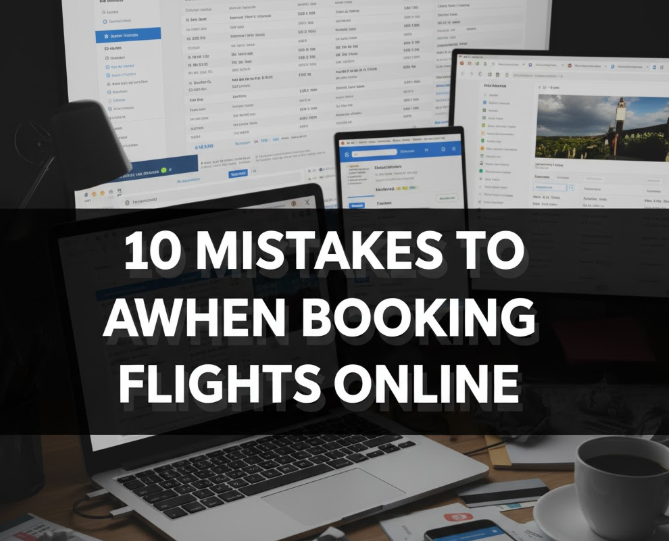You don’t have to let your wallet take a beating when you fly. Every year, millions of travelers pay too much for flights because they don’t know the hacks that well-practiced globetrotters use all the time. Whether you’re dreaming big for a family vacation, that bucket-list trip around the world or simply stepping away from your cubicle to enjoy some solo time off, being savvy about booking flights can mean the difference between getting there and breaking the bank.
Airline pricing is a complex set of algorithms that are adjusted several times a day for tickets. But I have good news: Frequent travelers have hacked the system. They’ve uncovered patterns, techniques, and proprietary tools that help them unearth cheaper flights than the rest of us. These are not some kind of hidden techniques that only travel agents and airline industry insiders know. But they’re efficiency hacks that just about anyone can employ, and we are about to share all seven of them with you.
Hack #1: Fly on the Magic Days
They say timing is critical when it comes to booking flights—but for me, that’s everything. Airlines operate very sophisticated computer systems that can change prices depending on demand, and these computer systems act in predictable ways, which smart travelers can use to their advantage.
The Tuesday-Wednesday Sweet Spot
The vast majority of frequent flyers book on Tuesday afternoons or Wednesday mornings. Why? Usually, once an airline releases its weekly sales on Monday evening, the competition has matched those prices by Tuesday afternoon. This results in a small window where prices decrease for all carriers at the same time.
Average Ticket Price by Booking Day:
| Day | Average Price |
|---|---|
| Sunday | $412 |
| Monday | $385 |
| Tuesday | $347 |
| Wednesday | $341 |
| Thursday | $368 |
| Friday | $398 |
| Saturday | $425 |
The Ideal Booking Window
Booking too early and booking too late both cost you money. The ideal booking window differs between locations, but seasoned travelers play by the following general rules:
| Trip Type | Recommended Booking Window | Estimated Savings |
|---|---|---|
| Domestic Flights | 1-3 months prior to departure | Up to 25% |
| International Flights | 2-8 months prior to departure | Up to 40% |
| Holiday Travel | 3-4 months before peak travel dates | Up to 35% |
| Last-Minute Deals | 3-14 days prior | Variable (risky!) |
Hack #2: Be Flexible with Everything
Rigid travel dates are the enemy of cheap flights. The savings between flying on a Thursday and a Saturday can be hundreds of dollars, and frequent fliers know how to take advantage of this flexibility.
Pro Tip: If you are going to leave for a full week, though — which I understand is not as simple a one-week stretch would be — think about leaving or returning on a Tuesday or Wednesday. Weekend flights are usually 20 to 30% more expensive than weekday flights due to higher demand from leisure travelers.
Date Flexibility Tools
Many flight search engines have a similar feature that allows you to compare prices over several days. Google Flights, Skyscanner, and Kayak have great flexible date searches. They show a grid of prices for various departure and return combinations, allowing you to quickly identify the cheapest times to fly.
Nearby Airport Options
Don’t restrict your options to just a single airport. Big cities frequently have more than one airport within driving distance, and prices may differ significantly between them. For instance, flying into Oakland instead of San Francisco or Fort Lauderdale instead of Miami can save you a bundle, even when factoring in the price of ground transportation.
Hack #3: Use Private Browsing and Clear Cookies
This hack may seem like conspiracy theory but experienced travelers swear by it. Airlines and other booking sites store your search data in “cookies,” which are snippets of information taken from searches or websites that allow sites to remember who you are as you surf around the internet. Some frequent travelers say they believe those cookies can result in higher fares or, depending on whom you ask, lower ones.
How Cookie Tracking Works
When you conduct a search for flights, websites use small files known as cookies to remember your search history. Though airlines claim they don’t use the information to jack up prices, plenty of travelers say they have seen lower fares after browsing without cookies and even clearing their online histories.
Important: Regardless of the extent to which cookies actually influence pricing, using private browsing mode offers an additional advantage in that it stops websites from displaying personalized ads for flights you’ve already searched for, ad messages that may induce a sense of psychological pressure on your part to book before prices “rise.”
The Multi-Device Strategy
Some frequent travelers go even further with this hack by looking at prices on other computers. They may look up a route on their laptop, then return to the same search on a phone or tablet. While the findings are generally the same, sometimes discrepancies arise especially for smaller booking platforms.

Hack #4: Use Multiple Tickets for Better Deals
Airlines’ pricing logic can seem to defy common sense. In some cases, booking two separate one-way flights is cheaper than a round-trip flight. Other times, it’s less expensive than a direct round-trip flight between two cities.
The Hidden City Ticketing Strategy
This sketchy yet legal life hack consists of booking a flight with a layover in your desired destination and instead, not boarding the second leg. For instance, if you are trying to fly from New York to Chicago, sometimes purchasing a ticket for a flight from New York to Denver and stopping in Chicago is cheaper than just getting a flight directly from New York to Chicago.
| Route | Price | Savings |
|---|---|---|
| Direct Flight: NYC → Chicago | $385 | — |
| Hidden City: NYC → Denver (layover Chicago) | $268 | Save $117 |
Warning: Hidden city ticketing is not for everyone. You can travel with only a carry-on (checked bags go through to the final destination), you cannot do this on round-trip tickets, and airlines may penalize frequent fliers who abuse this strategy. This is, officially, disapproved of by airlines but it remains legal.
Mix and Match Airlines
Don’t presume you have to book the same airline there and back. It can sometimes save you money to book your departure and return flights on different airlines. This trick works particularly well for international trips that have low-cost carriers flying one of the legs.
For more expert tips on finding the best flight deals, visit https://calltoflights.com.
Hack #5: Sign Up for Fare Alerts and Price Trackers
Regular travelers aren’t sitting for hours at a time, checking flight prices by hand. What they don’t do is waste half a Sunday browsing for cheap fares the old-fashioned way. Instead, they do the work of applying technology to their search process by setting up fare alerts that tell them when prices drop on flights between point A and point B.
Best Fare Alert Tools
There are a couple of great free tools that will alert you when flights go down in price:
- Google Flights Price Tracking: Tracks certain routes and dates, notifies by email when prices are at unusually low levels
- Hopper App: Predictive algorithms tell you whether to wait or book now for better prices
- Scott’s Cheap Flights: Forwards you the best finds out of your home airport, also including mistake fares and flash sales
- Airfarewatchdog: Lists prices from cheap but often low-profile carriers that other search engines don’t include
The Set-and-Forget Strategy
Smart travelers schedule alerts months before they hope to leave. This passive method automatically alerts you to any sales or price drops without you having to actively search for them. And when you see a remarkable sale, you can book that perfect flight now, rather than waiting and watching the price creep back up.
Hack #6: Use Credit Card Points and Miles
For frequent travelers, credit card rewards are basically a second currency. Luca Martucci is a member of several credit card rewards programs and does just that: The Berlin-based product manager strategically spends money with the right cards every day to rack up points that turn into free or heavily discounted flights.
The Point-Earning System
Most travel rewards credit cards earn extra points in certain categories. A more diversified approach would be to use various cards for different spending categories and reap the most points. For instance, one card for dining and travel purchases, perhaps another one for groceries and a third for everything else.
| Card Category | Best Use | Typical Point Value |
|---|---|---|
| Airline Co-branded Cards | Direct on an Airline | 1-2 cents per point |
| General Travel Cards | Multiple Airlines | 1.5-2 cents per point |
| Premium Travel Cards | International business class flights | 2-3 cents per point |
| Hotel Co-branded Cards | Hotel stays with flight transfer options | 0.8-1.5 cents per point |
Strategic Point Redemption
When you earn your points, and how you use them, is just as important. Experienced travelers save their points for expensive flights when the redemption value is best. A business class international ticket may have a cash price of $4,000 but cost only 75,000 points — more than 5 cents per point. Meanwhile, 75,000 points would likely cover only a $600 domestic flight, reducing the value to less than 1 cent per point.
Hack #7: Look into Budget Airlines and Alternate Routes
People who travel frequently are aware that the cheapest way to get from Point A to Point B is not always a straight line. Occasionally, flying a longer way around with budget airlines and interesting routing can save money.
Budget Carrier Benefits
Budget airlines such as Southwest, Spirit, Frontier, Ryanair and EasyJet advertise base fares that are significantly lower than those of traditional airlines. They do charge extra for bags, seat selection and snacks, but even with these add-ons the price is usually lower than that of legacy carriers.
If You Fly a Budget Airline: Travel light, and pack your own snacks. Budget airlines typically allow one free carry-on bag and personal item each way, so avoiding checked baggage fees can save you $50-100 per person.
The Creative Routing Strategy
On occasion, breaking a longer trip into parts means saving money. For example, you might find it cheaper to book Los Angeles to New York on a U.S. domestic carrier and New York to London on a European budget airline. This means handling two bookings, and perhaps fetching bags and rechecking them, but the savings can be $300-400 per ticket.
Secondary Airport Advantages
Low-cost airlines tend to fly in and out of secondary, smaller airports rather than the main transport hubs. This may mean a 30- to 60-minute ground transportation ride, though the savings on the flight (which often costs more) and shorter security lines are worth it for many passengers. Airports such as London Stansted, Paris Beauvais and Chicago Midway are frequently able to offer flights considerably cheaper than those of their larger rivals.

Frequently Asked Questions
When is the best day to book flights?
Flights are cheapest on Tuesdays and Wednesdays. Airlines usually release their sales for the week on Monday evenings, and by Tuesday afternoon, competing airlines will have matched the lower prices — creating a short-lived window of opportunity with fares at bargain-basement levels across multiple carriers.
When should I make the reservation for my flight?
But the perfect booking window varies by destination. For domestic flights, travelers should book 1-3 months in advance. 2-8 months in advance is ideal for international flights. Plans for holiday travel need to be made even further in advance — book at least 3-4 months before the most popular dates.
When I search multiple times on an airline’s website, do flight prices really go up?
Though airlines publicly deny using cookies to increase the prices of people’s flights, many travelers are actually seeing lower flight costs after they shut off their regular browsing mode and even use the private browsing function. While it’s unknown how directly this impacts pricing, using private browsing also prevents personalized ads that might increase pressure to book before prices update.
Are the budget airlines really cheaper when you factor in all their fees?
Yes, budget airlines normally remain more affordable even with add-on charges if you pack light. If you only take one carry-on bag and a personal item (which are usually free), you can avoid checked bag fees, seat selection charges and other add-ons. The overall cost is usually still less than flights offered by traditional airlines on the same route.
Is hidden city ticketing legal?
Yes, hidden city ticketing is legal, but it’s also against the rules according to similar “conditions of carriage” a customer agrees to when he or she purchases a ticket. Key restrictions: It can only be used for carry-on bags, the hack works only with one-way tickets and you must not take the final leg rather than first of your trip.
Should I book through airlines or use third-party sites?
Consult third-party sites like Google Flights or Skyscanner to compare prices, but think about booking directly through airlines. Booking direct pays off for changes and cancellations, usually better customer service, and in some cases price matching if you can find a lower fare elsewhere. But sometimes third-party sites have genuinely better prices that are worth the compromise.
How to maximize credit card points on flights?
Let travel rewards cards work for you by pairing cards together to earn bonus points on spending categories. Save your points for the most expensive flights where value is highest, such as business class international tickets. Think about working on moving those points around to get better redemption rates on certain flights with other programs.
What are mistake fares, and where do I find them?
Mistake fares come about when airlines or booking sites make pricing errors, offering discounts of 50 percent to as much as 90 percent in the case of (very) rare business-class mistakes. Sign up for fare alert services like Scott’s Cheap Flights or Secret Flying to notify you of these rare offers. Book fast — airlines often honor mistake fares, but may also rescind them within hours.
Your Cheap Flights Journey Starts Here
These seven hacks are the distillation of years’ worth of collective wisdom from travelers who have figured out how to find cheap flights. The distinction between buying at full price and getting a great deal can boil down to knowing these strategies — and having the patience to apply them regularly.
Begin with one or two hacks that feel most manageable for your specific situation. Establish fare alerts for destinations you want to visit, begin tapping away searches on Tuesdays and Wednesdays or consider applying for a travel rewards credit card. Once these techniques get easier, add in some more to your mental arsenal.
Keep in mind, flexibility is your best friend. The more bendy you can be on dates, airports and routings, the greater your chances of finding outstanding deals. A fixed itinerary puts you at the mercy of high-price airlines, but flexibility lets YOU decide when and how to fly according to value.
The confusing web of pricing systems in the airline industry is one more way that consumers get screwed, but now you have some wisdom to apply like a seasoned frequent flyer. These will not only save you some money on your next trip, they are guaranteed to change the way that you think about traveling. Every dollar saved on flights is a dollar you can spend on experiences at your destination — and that’s what travel is all about.
Safe travels and goodbye – best fares always!






